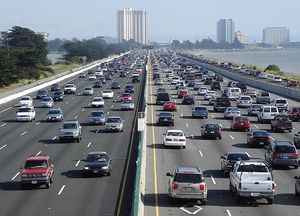Primary pollutant

Primary pollutants are any type of pollutant directly into the environment. They differ from secondary pollutants because secondary pollutants must form in the atmosphere, whereas primary pollutants do not. Primary pollutants can be emitted from many sources including cars, coal-fired power plants, natural gas power plants, biomass burning, natural forest fires, volcanoes, and many more.
The effects of primary pollutants are of concern as they can be harmful to humans, animals and plants.[2] Their contribution to the formation of secondary pollutants is also concerning, as this is what causes harmful ground level ozone to form, along with different smogs, especially in densely populated cities such as Los Angeles.
The emission of primary pollutants has decreased considerably in the past years, due to improved regulations, technology and economic changes.[3] Click here to see some cool images from NASA on how air pollution has decreased in the past years.
Types of primary pollutants include:[4]
- Nitrogen oxides (NOx)
- Carbon monoxide (CO)
- Volatile organic compounds (VOCs)
- Sulfur oxides (SOx)
- Particulate matter (PM)
- Mercury
- and more
Note*: Certain pollutants may be both primary and secondary pollutants. NOx for example is emitted from vehicles and power plants, yet it can also form in the atmosphere from other chemicals.
Data Visualization (Pollutants in Canada)
Transportation is the leading contributor of many primary pollutants due to burning of gasoline and diesel, which produce many of these harmful pollutants. The industrial sector is also a major contributor. The data visualization depicts the emissions of various primary pollutants by source and province. The drop down tabs at the top may be selected to switch between pollutants, along with delving into specific sectors to see exactly where these emissions come from.
For example:
Select "Nitrogen oxides" (preset) and "Industrial" to see how Alberta's upstream oil and gas industry contributes to NOx emissions.
or
Select "Lead" and "Industrial" to see how Quebec's smelting industry contributes to these emissions.
For Further Reading
References
- ↑ Wikimedia Commons [Online], Available: https://upload.wikimedia.org/wikipedia/commons/3/3e/I-80_Eastshore_Fwy.jpg
- ↑ BC Air Quality. (Accessed July 23, 2015). Pollutants: An Introduction [Online], Available: http://www.bcairquality.ca/101/pollutants-intro.html
- ↑ NASA. 2014. New NASA images highlight U.S. Air Quality Improvement [Online], Available: https://www.nasa.gov/content/goddard/new-nasa-images-highlight-us-air-quality-improvement/#.VbEhrrNVikp
- ↑ LSC Atmospheric Sciences. (Accessed July 23, 2015). Primary Pollutants [Online], Available: http://apollo.lsc.vsc.edu/classes/met130/notes/chapter18/primary.html

